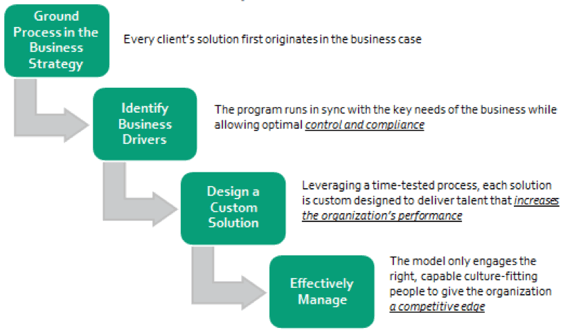
I often define HR as “everything people”, therefore the essence of HR has to be strategic. As HR expands beyond its traditional administrative role, that shift provides a significant impact on an organization’s value creation. To properly align HR with the business strategy, the structure must support having the senior HR leader involved in the strategic planning process. It’s then that HR leader’s responsibility to ensure the entire executive team understands that it is human capital that impacts all areas of an organization. In turn, the HR function needs to ensure the human asset is effectively aligned with the business strategy. The focus on business strategy needs to be addressed within every department of HR – Talent Acquisition, Compensation & Benefits, Performance Management, Employee Development & Employee Relations.
This approach may be a shift in the role of HR for some organizations and it requires HR leaders to think and execute differently. While it is a change, it’s a very welcomed change from HR leadership. HR leaders understand the impact they can drive, and provides the opportunity to lead their organizations through change management. Throughout my career, the most successful, productive and long-term partnerships have always been with organizations that have HR and the business leaders at the same table. Organizations that have successfully aligned HR with their business strategy have solved the following:
- They deliver value through integrating people strategies, processes and technologies
- They align HR decision-making with the business to maximize employee performance and company performance
Accomplishing these 2 key strategies doesn’t happen overnight. It requires the development of a strategic plan to structure the organization in a way that fosters success in each of these areas.
I have the great fortune of interacting with key business leaders on a regular basis. Through those interactions, I’ve identified 4 key business drivers in today’s economy:
- Talent (attracting, retaining, training and engaging)
- Driving innovation (in some markets disruptive innovation)
- Requires a process for evaluating innovation ideas
- Vision (management focus)
- Maintaining a strong culture with common core values.
Research demonstrates that organizations that effectively execute in these four key areas are more likely to experience sustained growth.
2022 Data: Why Employers Value Modern Recruitment Process Outsourcing Partnerships [Research Report]
RPO (Recruitment Process Outsourcing) plays a very strategic role in addressing these key business drivers. An effective talent acquisition function has the ability to directly impact each of these key business drivers. As the marketplace continues to evolve, the skills, experience and motivation of employees can be a major competitive advantage. It is HR’s obligation to deliver the right talent acquisition strategy to the organization and many have made the strategic decision to partner with an expert to make talent acquisition their strategic advantage.
At Advanced RPO, we’ve developed the Business Impact Model ® which is a predictable efficient system designed to source, recruit and screen highly engaged, capable talent who best fit the position and the culture of each client. The model was developed to guide the development of a talent acquisition program that aligns talent acquisition with the business strategy. As a matter of fact, the first step is understanding the business strategy, which then translates to the foundation of the solution. From there, the focus shifts to key business drivers; what competencies are critical to drive the organization forward? It also helps shape the go-to-market strategy to attract individuals that are culturally aligned. These details (and many more) determine the blueprint of the solution design. Ultimately, designing and executing a talent acquisition program that delivers talent that increases the organizations performance. On-going auditing, feedback and process improvement is the final step of this model. Although, when done accurately it simply continues to further evolve the program to continuously meet the organizational needs. Following is a high level summary of the Business Impact Model ®

Simply stated, your talent acquisition program has to be rooted within the organization’s business strategy. Just like every other function within HR, talent acquisition needs to drive strategic advantage for the organization. That is typically done most effectively by identifying the right RPO partner.
About the author: Pam Verhoff, President of Advanced RPO, is an accomplished executive leader that has extensive experience building RPO businesses and solutions, as well as developing growth strategy. Pam is responsible for all aspects of strategic planning, sales and marketing, operations, financial management and compliance for Advanced RPO. Her success has largely been a result of building high performance teams and creating a values-driven culture resulting in exceptional employee engagement.













